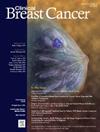Decrease in Calcifications After Neoadjuvant Treatment Predicts Invasive Tumor Response but Not Complete DCIS Eradication: Systematic Review and Meta-Analysis
IF 2.5
3区 医学
Q2 ONCOLOGY
引用次数: 0
Abstract
Changes in calcifications after neoadjuvant treatment and their relationship with pathological complete response in breast cancer remain unclear. We conducted a systematic review and meta-analysis to evaluate this association. A PubMed and EMBASE search was conducted for English-language studies assessing changes in calcification size or number before and after neoadjuvant treatment and their correlation with post-treatment histology. Pooled odds ratios and 95% confidence intervals were calculated using a random-effects model. Study heterogeneity, publication bias, and quality were assessed using the Cochrane Q test, I2 statistic, funnel plot, and Slim's method. Of 2261 records screened, 8 studies comprising 707 patients were eligible. Decreased calcifications after neoadjuvant treatment were associated with higher odds of achieving pathologic complete response (pooled odds ratio of 1.691, p < 0.001). Subgroup analyses showed significance for decrease vs. no-decrease (odds ratio = 2.045; p = 0.004), a trend for decrease vs. increase, and no significance for no-increase vs. increase. Stratification by pathologic complete response definition demonstrated significance when residual DCIS was permitted (odds ratio of 2.196; p < 0.001) but not when complete absence of DCIS was required. Patients with a decrease in calcifications after neoadjuvant treatment are twice as likely to achieve pathologic complete response, particularly when residual DCIS is permitted within the pathologic complete response definition. Calcification changes may serve as an additional tool for guiding surgical planning after neoadjuvant treatment.
新辅助治疗后钙化减少预测侵袭性肿瘤反应,但不能完全根除DCIS:系统回顾和荟萃分析。
乳腺癌新辅助治疗后钙化的变化及其与病理完全缓解的关系尚不清楚。我们进行了系统回顾和荟萃分析来评估这种关联。通过PubMed和EMBASE检索英语研究,评估新辅助治疗前后钙化大小或数量的变化及其与治疗后组织学的相关性。使用随机效应模型计算合并优势比和95%置信区间。采用Cochrane Q检验、I2统计量、漏斗图和Slim方法评估研究异质性、发表偏倚和质量。在筛选的2261份记录中,8项研究包括707名患者符合条件。新辅助治疗后钙化减少与达到病理完全缓解的几率较高相关(合并优势比为1.691,p < 0.001)。亚组分析显示减少与未减少具有显著性(优势比= 2.045;P = 0.004),有减少与增加的趋势,无增加与增加的差异无统计学意义。当允许存在残余DCIS时,病理完全缓解定义分层具有重要意义(优势比为2.196;p < 0.001),但当完全不需要DCIS时则不存在。新辅助治疗后钙化减少的患者达到病理完全缓解的可能性是其两倍,特别是当病理完全缓解定义内允许残留DCIS时。钙化变化可作为新辅助治疗后指导手术计划的附加工具。
本文章由计算机程序翻译,如有差异,请以英文原文为准。
求助全文
约1分钟内获得全文
求助全文
来源期刊

Clinical breast cancer
医学-肿瘤学
CiteScore
5.40
自引率
3.20%
发文量
174
审稿时长
48 days
期刊介绍:
Clinical Breast Cancer is a peer-reviewed bimonthly journal that publishes original articles describing various aspects of clinical and translational research of breast cancer. Clinical Breast Cancer is devoted to articles on detection, diagnosis, prevention, and treatment of breast cancer. The main emphasis is on recent scientific developments in all areas related to breast cancer. Specific areas of interest include clinical research reports from various therapeutic modalities, cancer genetics, drug sensitivity and resistance, novel imaging, tumor genomics, biomarkers, and chemoprevention strategies.
 求助内容:
求助内容: 应助结果提醒方式:
应助结果提醒方式:


